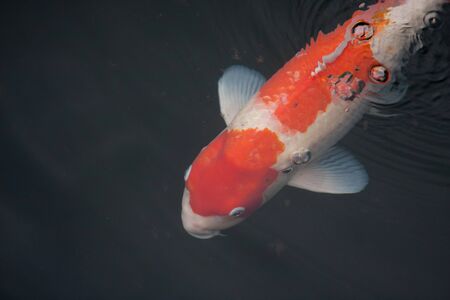1. Understanding Fungal Infections in Aquarium Fish
Fungal infections are a common issue in aquarium fish, affecting both freshwater and saltwater species. These infections are caused by various types of fungi, primarily from the Saprolegnia and Aphanomyces families. While they can be treated if caught early, untreated fungal infections can weaken fish and lead to secondary health problems.
What Are Fungal Infections?
Fungal infections occur when opportunistic fungi invade weakened or injured fish. These infections typically appear as white or gray cotton-like growths on the skin, gills, fins, or mouth. The fungi thrive in environments with poor water quality, high organic waste, or stressed fish.
How Do Fungal Infections Develop?
Fungi are always present in aquariums but usually do not harm healthy fish. However, certain conditions can make fish more vulnerable to fungal infections:
| Risk Factor | Description |
|---|---|
| Injuries | Open wounds from fights, rough handling, or sharp decorations allow fungal spores to enter. |
| Poor Water Quality | Dirty water with high ammonia or nitrate levels weakens the fish’s immune system. |
| Weakened Immune System | Stress from overcrowding, improper diet, or sudden temperature changes makes fish more susceptible. |
| Previous Illness | Bacterial or parasitic infections can weaken fish, making them prone to fungal growth. |
The Impact of Fungal Infections on Fish Health
If left untreated, fungal infections can spread and severely impact a fish’s well-being. Symptoms may include difficulty swimming, loss of appetite, and increased stress levels. In severe cases, the infection can spread internally, leading to organ damage and death.
2. Common Signs and Symptoms
Fungal infections in aquarium fish can be tricky to spot at first, but knowing what to look for can help you take action quickly. These infections often affect the skin, fins, and gills of fish, causing visible changes and unusual behavior.
Visual Symptoms
One of the most noticeable signs of a fungal infection is the presence of white or gray cotton-like growths on your fish. These patches typically appear on the body, fins, or mouth and may spread if left untreated. Below is a table summarizing the common visual symptoms:
| Symptom | Description |
|---|---|
| White or gray fuzzy patches | Cotton-like growths on the skin, fins, or mouth |
| Discolored skin | Pale or reddened areas around infected regions |
| Torn or frayed fins | Deterioration of fin edges due to infection spread |
| Sores or lesions | Open wounds that may result from severe infections |
Behavioral Symptoms
Apart from physical signs, infected fish may also behave differently. If you notice any of these behaviors, your fish might be dealing with a fungal infection:
- Lethargy: Infected fish often become less active and spend more time resting at the bottom or near the surface.
- Lack of Appetite: Affected fish may stop eating or show reduced interest in food.
- Scratching Against Objects: Fish may rub their bodies against decorations, gravel, or tank walls due to irritation.
- Difficult Breathing: If the infection spreads to the gills, fish may struggle to breathe and gasp at the surface.
![]()
3. Causes and Risk Factors
Fungal infections in aquarium fish are often caused by a combination of environmental and biological factors. Understanding these causes can help you prevent infections and keep your fish healthy.
Environmental Factors
The conditions in your aquarium play a significant role in the development of fungal infections. Poor water quality, inadequate filtration, and fluctuating temperatures can weaken a fishs immune system, making them more susceptible to infections.
Poor Water Quality
Dirty or unfiltered water allows harmful bacteria and fungi to thrive. Regular water changes and proper filtration help maintain a clean environment that discourages fungal growth.
Fluctuating Temperature
Sudden temperature changes stress fish, weakening their immune response. Keeping a stable water temperature within the recommended range for your fish species is crucial.
Overcrowding
An overcrowded tank leads to increased waste and reduced oxygen levels, creating an unhealthy environment where fungi can flourish.
Biological Factors
Certain biological conditions also increase the risk of fungal infections. These include injuries, weakened immune systems, and existing diseases.
Injuries and Open Wounds
Scrapes, bites, or damage from rough decorations can create entry points for fungal spores, leading to infection.
Weakened Immune System
Poor nutrition, stress, or underlying health issues can weaken a fish’s immune system, making it more prone to infections.
Existing Diseases
If a fish is already battling another illness, such as bacterial infections or parasites, it becomes more vulnerable to secondary fungal infections.
Common Risk Factors Summary
| Risk Factor | Description |
|---|---|
| Poor Water Quality | Dirty or unfiltered water allows fungi to grow. |
| Fluctuating Temperature | Sudden changes weaken fish immunity. |
| Overcrowding | Leads to higher waste levels and lower oxygen. |
| Injuries | Cuts and wounds provide entry points for fungi. |
| Poor Nutrition | Lack of essential nutrients weakens immunity. |
| Existing Diseases | Sick fish are more vulnerable to fungal infections. |
By managing these environmental and biological factors, you can reduce the likelihood of fungal infections in your aquarium fish. Regular tank maintenance, proper feeding, and monitoring your fish’s health will go a long way in preventing these issues.
4. Effective Treatment Methods
When dealing with fungal infections in aquarium fish, it’s important to act quickly to prevent the infection from spreading. There are several treatment options available, ranging from medications to natural remedies and quarantine procedures.
Medications for Fungal Infections
Medications are one of the most effective ways to treat fungal infections in fish. These treatments help eliminate the fungus and prevent further spread.
| Medication Type | Usage Instructions | Notes |
|---|---|---|
| Antifungal Fish Medications (e.g., Methylene Blue, Malachite Green) | Add recommended dosage to the aquarium or use as a dip treatment. | Follow dosage instructions carefully to avoid harming fish. |
| Aquarium Salt | Dissolve in water before adding to the tank. | Helps with mild infections but should not be used with salt-sensitive species. |
| Potassium Permanganate | Use as a short-term bath treatment. | Effective but must be handled with caution as it can harm beneficial bacteria. |
Natural Remedies
If you prefer a more natural approach, there are some home remedies that may help combat fungal infections:
- Tea Tree Oil (Melafix): Known for its antifungal properties, this can be added in small doses to promote healing.
- Aloe Vera Extract: Helps soothe affected areas and boost the fishs immune system.
- Indian Almond Leaves: Release tannins into the water, creating a more natural antifungal environment.
Quarantine Procedures
Isolating infected fish is crucial to preventing the spread of fungal infections. Follow these steps for an effective quarantine procedure:
Setting Up a Quarantine Tank
- Select a Separate Tank: Use a clean, cycled tank with proper filtration and aeration.
- Maintain Optimal Water Conditions: Keep water parameters stable to reduce stress on the sick fish.
- Treat with Medications if Needed: Administer appropriate antifungal treatments in the quarantine tank.
- Monitor Daily: Observe for signs of improvement or worsening symptoms before reintroducing the fish.
When to Return Fish to the Main Tank
Aquarium fish should only be moved back after showing no signs of infection for at least a few days. Ensure that their wounds have healed completely and that they are active and eating normally.
Treating fungal infections effectively requires patience and consistency. By using the right combination of medications, natural remedies, and quarantine procedures, you can help your fish recover and maintain a healthy aquarium environment.
5. Prevention and Long-Term Care
Keeping your aquarium fish healthy and free from fungal infections requires consistent care and a well-maintained environment. By following best practices, you can minimize the risk of infections and ensure your fish thrive.
Maintain Clean Water Conditions
Poor water quality is one of the main causes of fungal infections in aquarium fish. Regularly testing and maintaining optimal water parameters will help keep your fish healthy.
| Water Parameter | Recommended Levels |
|---|---|
| Temperature | Varies by species, generally 74-80°F (23-27°C) |
| pH Level | 6.5 – 7.5 |
| Ammonia | 0 ppm |
| Nitrites | 0 ppm |
| Nitrates | <20 ppm |
Regular Tank Maintenance
A clean tank reduces the chances of harmful bacteria and fungi growing. Follow these maintenance steps:
- Perform partial water changes (20-30%) weekly.
- Vacuum substrate to remove uneaten food and waste.
- Clean decorations and filter components as needed.
- Avoid overfeeding to prevent excess waste buildup.
Quarantine New Fish and Plants
New fish or plants can introduce harmful fungi and bacteria into your aquarium. Quarantining them before adding them to your main tank helps prevent infections.
How to Quarantine New Fish:
- Set up a separate quarantine tank with similar water conditions.
- Observe new fish for at least two weeks for any signs of illness.
- Treat any visible infections before introducing them to the main tank.
Avoid Stress Factors
Stress weakens a fish’s immune system, making it more vulnerable to fungal infections. Common stress factors include:
- Poor water quality
- Aggressive tank mates
- Sudden temperature changes
- Lack of hiding spots or overcrowding
Select Healthy Fish and Quality Food
A strong immune system helps fish fight off infections naturally. Feeding high-quality, varied food ensures they get essential nutrients.
- Select reputable sources when buying fish.
- Avoid sick or injured fish when purchasing new ones.
- Provide a balanced diet with flakes, pellets, frozen, or live food.
Monitor Your Fish Regularly
Keen observation is key to early detection of fungal infections. Look for symptoms like white cotton-like growths, lethargy, or unusual swimming behavior.
If You Notice Symptoms:
- Isolate the affected fish immediately.
- Treat with antifungal medication if necessary.
- Check water parameters and correct any imbalances.
A proactive approach to aquarium maintenance keeps fungal infections at bay and ensures your fish stay happy and healthy in the long run!


